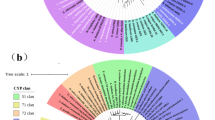Abstract
Caffeine (1,3,7–trimethylxanthine) is one of the most widely used plant secondary metabolites, primarily as a stimulant and an ingredient in drugs. In nature, caffeine is believed to function in chemical defense, acting as an antiherbivory and allelopathic agent, and therefore it might be employed to protect agriculturally important crop plants. In coffee plants, caffeine is synthesized from the precursor xanthosine in four steps, three N-methylations and removal of ribose. We had previously isolated genes encoding three distinct N-methyltransferases, and we demonstrated production of recombinant enzymes that yielded caffeine in in vitro reconstitution experiments. When these caffeine biosynthetic pathway genes were simultaneously expressed in tobacco plants (Nicotiana tabacum), caffeine was successfully produced up to 5 µg/g fresh weight in leaves. The leaves were unpalatable to tobacco cutworms (Spodoptera litura). This repellent action appeared to be more widely␣applicable to lepidopteran caterpillars as observed with small white (Pieris rapae) fed on Chinese cabbages that had been top-treated with caffeine. Our recent results suggest a novel approach to strengthen anti-herbivore traits by producing caffeine in crop plants.
Similar content being viewed by others
References
Ashihara H, Crozier A (1999) Biosynthesis and metabolism of caffeine and related purine alkaloids in plants. Adv Bot Res 30:118–205
Ashihara H, Crozier A (2001) Caffeine: a well known but little mentioned compound in plant science. Trends Plant Sci 6:407–413
Chou CH, Waller GR (1980) Possible allelopathic constituents of Caffea arabica. J Chem Ecol 6:643–654
Croteau R, Kutchan TM, Lews NG (2000) Natural products (secondary metabolites). In: Buchanan BB, Gruissem W, Jones RL (eds) Biochemistry and molecular biology of plants. American Society of Plant Physiologists, Rockville, pp 1250–1318
Hammer-Jespersen K, Buxton RS, Hansen TD (1980) A second purine nucleotide phosphorylase in Escherichia coli K-12. II. Properties of xanthosine phosphorylase and its induction by xanthosine. Mol Gen Genet 179:341–348
Hollingsworth RG, Armstrong JW, Campbell E (2002) Caffeine as a repellent for slugs and snails: at high concentrations this stimulant becomes a lethal neurotoxin to garden pests. Nature 417:915–916
Jouanin L, Bonade-Bottino M, Girard C, Morrot G, Giband M (1998) Transgenic plants for insect resistance. Plant Sci 131:1–11
Mathavan S, Premalatha Y, Christopher MSM (1985) Effects of caffeine and theophylline on the fecundity of four lepidopteran species. Exp Biol 44:133–138
Mizuno K, Okuda A, Kato M, Yoneyama N, Tanaka H, Ashihara H, Fujimura T (2003) Isolation of a new dual-functional caffeine synthase gene encoding an enzyme for the conversion of 7-methylxanthine to caffeine from coffee (Coffea Arabica L.). FEBS Lett 534:75–81
Nathanson JA (1984) Caffeine and related methylxanthine possible naturally occurring pesticides. Science 226:184–187
Ogita S, Uefuji H, Morimoto M, Sano H (2005) Metabolic engineering of caffeine production. Plant Biotech 22:461–468
Ogawa M, Herai Y, Koizumi N, Kusano T, Sano H (2001) 7-Methylxanthine methyltransferase of coffee plants: gene isolation and enzymatic properties. J Biol Chem 276:8213–8218
Rizvi SJH, Mukerji D, Mathur SN (1981) Selective phyto-toxicity of 1,3,7-trimethylxantine between Phaseorus mungo and some weeds. Agric Biol Chem 45:1255–1256
Shelton AM, Wyman JA, Cushing NL, Apfelbeck K, Dennehy TJ, Mahr SER, Eigenbrode SD (1993) Insecticide resistance of diamondback moth in North America. J Econ Entomol 86:11–19
Uefuji H, Ogita S, Yamaguchi Y, Koizumi N, Sano H (2003) Molecular cloning and functional characterization of three distinct N-methyltransferases involved in the caffeine biosynthetic pathway in coffee plants. Plant Physiol 132:372–380
Uefuji H, Tatsumi Y, Morimoto M, Kaothien-Nakayama P, Ogita S, Sano H (2005) Caffeine production in tobacco plants by simultaneous expression of three coffee N-methyltransferases and its potential as a pest repellant. Plant Mol Biol 59:221–227
Wildung MR, Croteau RB (2005) Genetic engineering of peppermint for improved essential oil composition and yield. Transgenic Res 14:365–372
Acknowledgements
This work was supported by a grant from the Research for the Future Program of the Japan Society for the Promotion of Science and by a Grant-in-Aid for the 21st Century COE Research from the Ministry of Education, Culture, Sports, Science and Technology.
Author information
Authors and Affiliations
Corresponding author
Rights and permissions
About this article
Cite this article
Kim, YS., Uefuji, H., Ogita, S. et al. Transgenic tobacco plants producing caffeine: a potential new strategy for insect pest control. Transgenic Res 15, 667–672 (2006). https://doi.org/10.1007/s11248-006-9006-6
Received:
Accepted:
Published:
Issue Date:
DOI: https://doi.org/10.1007/s11248-006-9006-6




